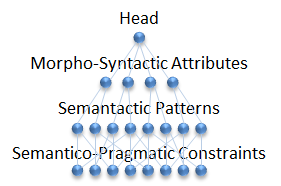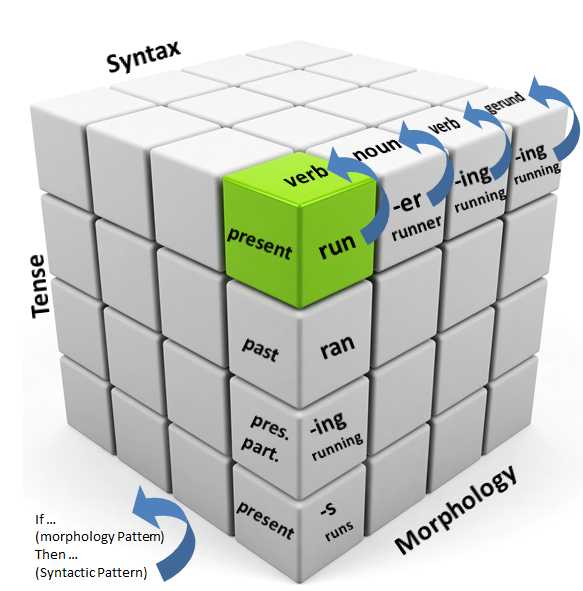13 May Patterns at the Boundaries
 Morphological Patterns
Morphological Patterns
As we have shown in prior posts, we mentally process patterns both at a physical level between neurons and in brain layers, and at a cognitive level in recognition and reasoning. 3-DG uses attributes, patterns and constraints for morphological analysis, as well as analysis at other levels and between other strata. The 3-DG lexicon is organized to hold this data in the tree structure illustrated at right. In this model, any word can be the head, as well as some idiomatic phrases that act like single words.
| Understanding Context Cross-Reference |
|---|
| Click on these Links to other posts and glossary/bibliography references |
|
|
|
| Prior Post | Next Post |
| Word Structure Analysis | Analyzing Syntax |
| Definitions | References |
| neurons brain layers | Duda 1973 Hammond 1988 |
| recognition reasoning constraints | Winograd 1983 |
| lexicon idiom word | Jappinen 1986 Dressler 1988 |
The morpho-syntactic pattern rules are simple feature logic statements that apply to each form of the lexical item. These are implemented as discreet logic objects in an ontology. This phenomenon crosses the boundary between the linguistic strata of morphology and syntax to produce transformations in word structure and phrase/sentence structure.
There are also patterns at the boundaries of syntax and semantics. The semantactic patterns (rules linking semantic patterns with syntactic implications) are phrase structure rules expressed as sequences of meaning linked to structure markers, that apply to idioms or words. The rules combine category, case and thematic role information so each semantactic pattern rule describes the predicted attributes of each of the elements in the combination. For example READ (*) has several semantactic pattern rules showing predicted sequence with arrows “>”, one of which looks like this:
NP/Agent + human > (*)Active Vt > NP/Object -animate>NP/Patient +human
The following list shows major morphological attributes based on detectable feature patterns:
| Tense | Possession | Negation | |
| Gender | Number | Aspect/Modality | |
| Definite/Indefiniteness | Polite/Honorific |
The pattern-based description of the features and rules in 3-DG provides for both left and right search in the sentence. SLPs are organized in the lexicon in probabilistic sequence. The semantactic parse attempts to match the patterns in the SLP with features in the adjacent words and phrases in the sentence. If adjacent items do not match, the constraints are relaxed, and the search is extended to near neighbors. When the constraints are relaxed, the confidence value of the result is lowered so the SLP with the best confidence value is accepted. To facilitate this, the lexicon contains weighted patterns.
Morphotaxia
Generally, morphology deals with internal structure or grammar of words while syntax deals with relationships between words that govern clause, phrase, and sentence structure or grammar. One of the most common morphological phenomena is affixation.
The extent to which inflection governs meaning and reduces ambiguity in a language has an impact on the importance and rigidity of word-ordering rules. Consequently, highly inflected languages such as Greek and Latin are much less dependent on word-order rules and more dependent on morphological changes than less inflected languages such as English and Chinese. But even for less inflected languages, a strictly transformational approach using context-free rewriting rules has proven to be nearly impossible. The sheer volume of categorical nodes overburdened the process, making it impossible to complete the analysis.
The necessity of having an independent mechanism for morphological analysis and description has been convincingly proposed by computational linguists [Jackendoff, 1972; Hammond & Noonan, 1988].
The true nature of the question of the appropriate role of morphology in grammar formalisms designed for automated systems is articulated in the excerpt behind the “Show Quote” button.
Syntax
Syntax, also referred to as grammar, is the structural element of language understanding. Syntactic analysis through parsing has been the focus of most natural language processing systems to date, which is probably the reason for the virtual absence of fully automatic machine-translation systems. Nonetheless, syntax is a critical component. In reading, syntax provides the majority of the cues for understanding unambiguous text, which arguably constitutes a large percentage if not a majority of the text we read.
Some syntactic clues are unmistakable. For example, in English, determiners tell us what to expect in successive words with relative consistency. The words THE, A, ANY, EVERY, THIS and THAT are consistently followed by other components of noun phrases: adjectives and nouns.
In Japanese, particles acting as postpositional cues clarify the thematic (semantic) and some syntactic constraints for the word or phrase immediately preceding the particle. The particles WA ( ) and GA ( ) always follow the subject, which will naturally be nominal, while O ( ) follows the object. The verb almost always finishes the sentence.
Syntactic processing is an extremely important part of the process of disambiguating polysemous words in text. As far as most people are concerned, the role of syntax is less interesting than the interactions of morphology and syntax and syntax and semantics.
The interaction between semantics and pragmatics is the most important in natural language processing because it enables us to apply context to resolve ambiguity. This will be discussed further in upcoming posts.
| Click below to look in each Understanding Context section |
|---|
| Intro | Context | 1 | Brains | 2 | Neurons | 3 | Neural Networks |
| 4 | Perception and Cognition | 5 | Fuzzy Logic | 6 | Language and Dialog | 7 | Cybernetic Models |
| 8 | Apps and Processes | 9 | The End of Code | Glossary | Bibliography |










